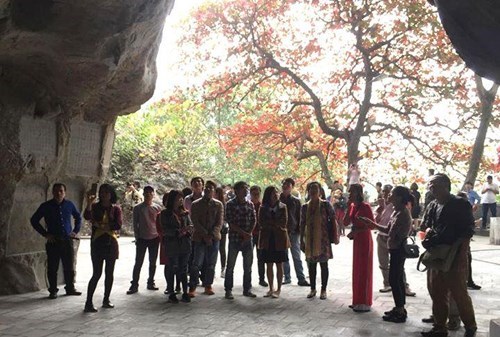December 19, 2017 | 22:13 (GMT+7)
Discovering caves in Kinh Mon district, Hai Duong province
PANO – The An Phu-Kinh Chu-Nham Duong Complex in Kinh Mon district, Hai Duong province has been recognized as the Special National Relics in acknowledgement of its great historical, cultural, and archaeological values.
The highlight of the relics is the Cao temple on the peak of An Phu mountain range in An Sinh commune. The temple was built in the Tran Dynasty (13th century) to pay homage to Tran Lieu - father of national hero Grand Duke Tran Quoc Tuan.
    |
 |
| Tourists visiting Kinh Chu cave |
In the temple's precinct, there is Tuong Van Pagoda, a worshiping place of Buddha and King Monk Tran Nhan Tong – the founder of the Truc Lam Yen Tu Buddhism Zen Sect.
About 50m lower than and approximately 300m from the front of the temple is a stone statue nearly 13m high depicting Grand Duke Tran Quoc Tuan looking towards the Northeastern borderland of Vietnam with one hand on the tip of a sword and the other hand holding a book.
Meanwhile, Kinh Chu Cave is located on the Southern slope of Duong Nham limestone mountain range, in Pham Menh commune, with lanceolate rocks. Notably, many figures in feudal dynasties visited the cave and left their meditations on the country’s situations on 54 unique epitaphs directly engraved on the cave’s cliffs.
Nearby, Nham Duong in Duy Tan commune is a scenic spot with grandiose mountains, uneven cliffs, and dozens of enchanting caves. These caves with prehistoric objects draw special attention of archaeologists.
Noticeably, these rock mountains in Kinh Mon district witnessed many struggles by our forefathers against foreign invaders. In the war against the Yuan-Mongolian, King Tran Nhan Tong garrisoned his soldiers on Duong Nham mountain. In the national resistance wars against French and then US invaders, the system of caves here was turned into secret bases for Vietnamese revolutionary cadres and troops.
In order to bring into play the values of the complex, in the coming time, authorities at all levels in the province will continue to pay attention to preserving and restoring the scenery and environment of these relics.
Translated by Van Hieu